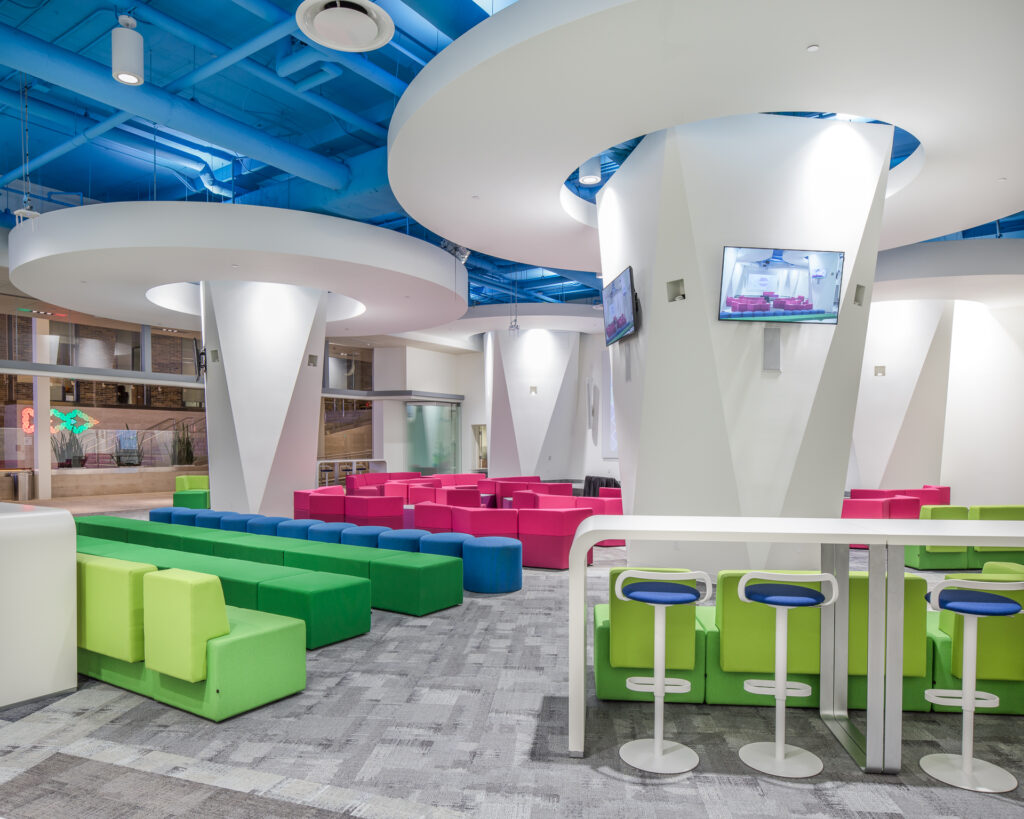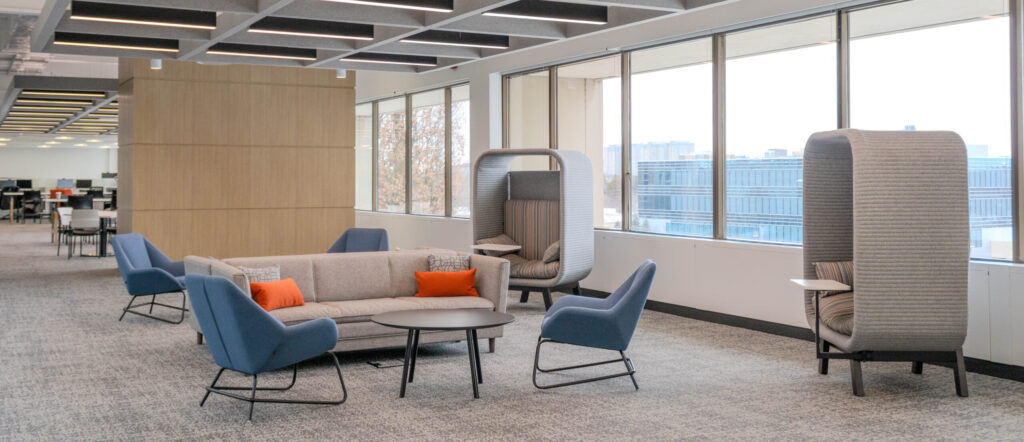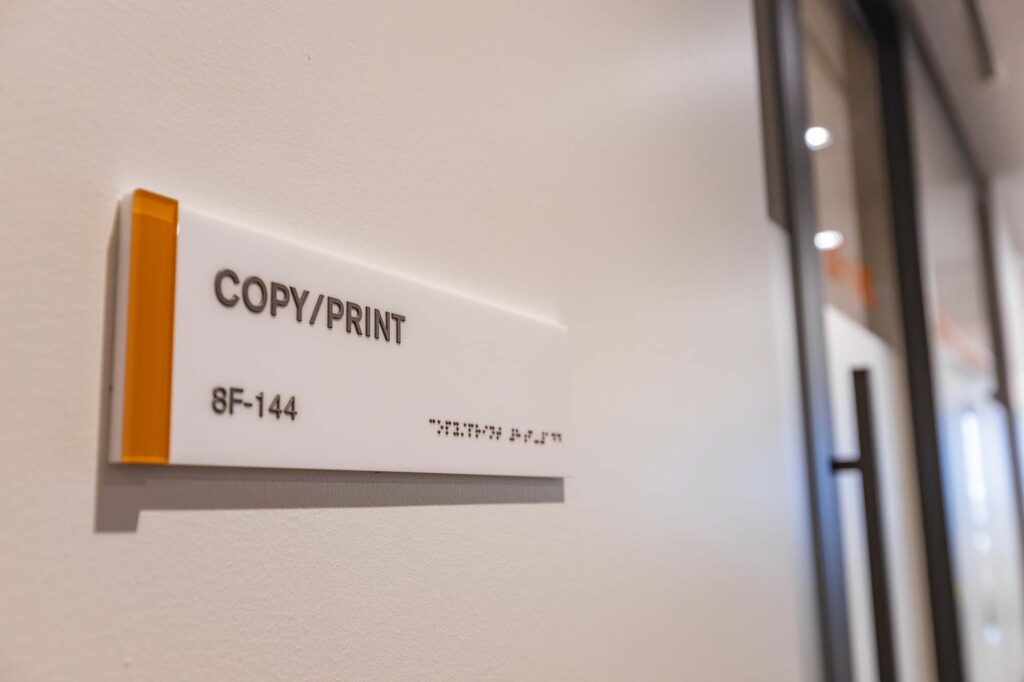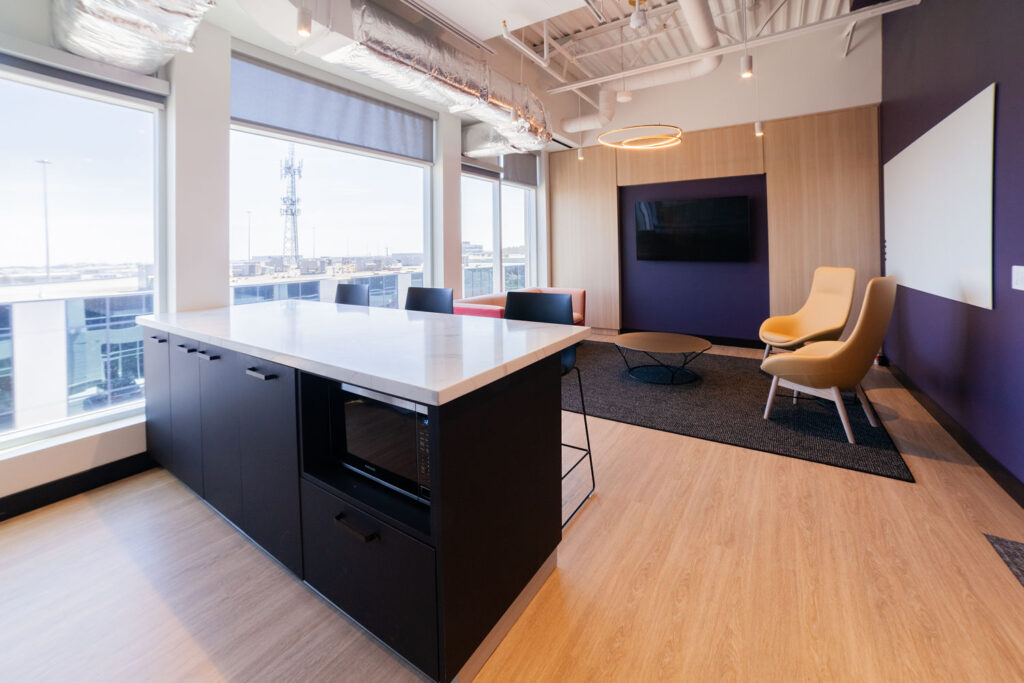Workplace strategy acts as a critical link between an organization’s business objectives—such as growth, innovation, and operational efficiency—and the physical and digital environments that support how employees work. Prior to any commencement of planning these strategic goals and initiatives are understood, analyzed, aligned, as an overarching company objective. A companies real estate portfolio is then analyzed and observed to understand how it is currently being used and where efficiencies can be made and enhanced to ensure that the right footprint is in place for the business.
This evaluation or analysis can result in a decrease of real estate needs and/or a potential increase or consolidation of real estate. It is key to understand how a business operates as a stand-alone entity as well as globally if applicable. How do staff and clients engage within the built environment, what type of activities are done within the space. As workplace strategists, we are committed to questioning whether the current way of working truly supports the future needs of the organization. We challenge the “why” in order to explore the possibilities of “what if.” It’s the “what if” that helps ensure a company’s success by building in flexibility, adaptability, and potential for growth from day one.
In today’s dynamic work environment, companies are reevaluating how their physical spaces can better support their people, processes and long-term goals. In turn, effective office design isn’t just about improving aesthetics or meeting industry trends. It’s about aligning a space with employee needs and business objectives.
What is a workplace strategy?
Workplace strategy is the intentional planning and design of an office that supports an organization’s goals, growth and workforce. It takes into account a company’s culture, the tasks employees perform, the tools they use, and the ways they collaborate. While traditional office design often emphasizes form over function, workplace strategy begins with a deep understanding of how a business operates.
The rise of hybrid work models and flexible schedules have made workplace strategy more important than ever. Businesses can no longer rely on outdated or generalized assumptions about how people should work. Employees expect purpose-built spaces that support different working styles, whether that’s focusing with heads-down or brainstorming in larger groups.
Workplace strategies never follow a one-size-fits all approach. They’re backed by research, analysis and continuous collaboration with the client. While results and recommendations may vary for each business, the overarching goals tend to include:
Flexibility
How can a workplace accommodate a variety of needs and make room for autonomy, hybrid work and future expansion?
Employee wellbeing
How can a workplace improve employee happiness, retention and general wellbeing?
Increased productivity
How can a workplace encourage engagement, collaboration and growth?

“Workplace strategy creates a clearly defined road map. The final destination? An optimized environment that supports an organization’s work patterns, increases productivity and enhances employee well-being.“
– Lauren Samery, Interior Designer & Team Lead
Creating a custom workplace strategy
At Mayhew, we create workplace strategies that integrate data, dialogue and design. We collaborate closely with our clients as they learn about their existing trends, map out goals and navigate change. Intentional solutions are at the forefront of our approach.
When designing a workplace strategy, we familiarize ourselves with the business and current workspace from top to bottom. We’re not looking for a quick fix. As a workplace solutions company, we handle the entire strategic process from initial discovery, all the way to implementation and education. Our process includes:
Leadership engagement
Discovery begins with a focused session that connects the organization’s leadership team with our strategists. We work together to identify current pain points, key drivers, strategic objectives, and business culture. Our goal is to understand what the executive team wants from their space and where we can make the most impact. This early alignment ensures that our workplace strategy is grounded in a broader, high-level vision.
Alignment and criteria
Next, we gather deeper insights from frontline managers and department leads. These individuals bring a different, equally critical perspective that’s often more specific to the day-to-day realities of team operations. We aim to gather as much information as we can to get a deeper understanding of how employees work and collaborate, what challenges they currently face and what facility utilization looks like. This step bridges the gap between executive vision and employee experience, ensuring that our strategy is balanced to both overarching goals and daily realities.
Employee surveys
While leadership teams and managers offer us great insight into workforce trends, it’s always important to involve as many individuals as we can. Everyone offers a unique perspective that can help drive future change. To amplify employee voices at scale, we design and share an electronic survey that targets the ten most important factors influencing workspace satisfaction. These factors typically include:
- Frequency of office use
- Desired features like quiet zones and collaborative spaces
- Office comfort, lighting, noise and ergonomics
- Preferences around autonomy and hybrid flexibility
Electronic surveys allow us to gather individual perspectives at scale. Whether we’re working with a team of 20 or 2,000, we’re still able to make the entire workforce feel included, valued and heard. An effective workplace strategy is one that everyone feels a part of, even in large companies.

“Our goal is to understand our clients’ business and their people. If we don’t understand that, we can’t hope to design a space that will provide them the right solution. Throughout the strategy process, we become part of their team.”
– Joan Phillips, Design Principal & Executive Vice President
Utilization studies
Observing and monitoring how people actually use a space is an important step to understanding utilization. We often find that the way employees actually use a space is not as closely matched to how they think they use the space. During the utilization study phase, we aim to figure out how often areas are used, where people gather, which spaces are underused and how long employees spend in different zones. Data that we collect during the utilization study phase helps us optimize layouts, reduce inefficiencies, and guide investment in the right furniture or technology.
At Mayhew, we study office utilization using a combination of technology tracking and manual observation.
Manual observation
Manual observation includes a member or members of the Mayhew team physically observing how employees are using their space. Over a period of three to four weeks, we embed ourselves into the business and are able to track daily habits, underused spaces and overcrowded facilities.
Tracking tools
There are several utilization tools that can help us understand employee habits over longer periods of time. elia is an incredibly useful tracking tool that uses discreet sensors to monitor employee movement. Data from the sensors feeds into utilization heat maps that can paint a clearer picture of how desks, shared spaces and meeting rooms are currently used.
Change management
Strategy alone isn’t enough. How we integrate and manage strategic change is critical to its success. After a workplace strategy is implemented, we help our clients understand and use their new space with training, onboarding and ongoing support.
Communication
We help our clients educate their staff on ways of working, new spaces and office technology.
Technology integration
We help our clients understand how their booking technology works and ensure its used effectively and accurately across teams.
Behavioural Protocols
We help teams understand how to act in collaborative, quiet and communal spaces to maintain their unique intention and purpose.
How workplace strategy can affect your environment
A well-crafted workplace strategy does more than make your office look good, it makes your office work better. A targeted and well thought out workplace strategy will help increase your productivity, performance and business growth. Positive outcomes of a workplace strategy in action include:
More choice and autonomy
Modern employees don’t just care about where they work, but how they work. A strong workplace strategy provides them with the flexibility they need to collaborate, work quietly and stay inspired. To offer employees the autonomy they crave, we encourage designating spaces within the office for specific moods, behaviours and purposes, including:
- Quiet zones
- Collaborative hubs
- Informal areas
- Wellness rooms, faith rooms, or relaxation spaces
Space optimization
Utilization studies often reveal surprising inefficiencies like unused meeting rooms or overcrowded zones. With this insight, businesses can improve their layout to increase accessibility and meet demand. Space optimization includes:
- Reconfiguring layouts for flow and accessibility
- Resizing or repurposing spaces based on actual demand
- Avoiding overbuilding or leasing more space than needed
Cost savings
Creating an effective workplace doesn’t have to mean spending more. It means spending smarter. A tailored workplace strategy helps companies make more informed financial decisions and invest in the right tools, technology and furniture that actually make a positive impact.
Employee wellness
When employees feel inspired and supported in their environment, productivity and engagement improves. From lighting and climate to furniture and layout, every detail in a workplace can either elevate or hinder the employee experience. Strategy helps employees feel supported, included and comfortable. This often means:
- Collaboration becomes easier
- Engagement grows
- Employee retention improves
Flexibility
Flexibility in the workplace involves careful consideration of hybrid working styles, space utilization and a company’s future growth.
When the projected growth of an organization is understood, we can look at how a space can support current needs while looking ahead to what might be required in the long term.
If there’s one thing the pandemic has taught us, it’s that hybrid work is here to stay. Offices must evolve to ensure in-person and remote employees can collaborate effectively. Workplace strategy takes this into account and enables:
- Smart scheduling and booking tools
- Spaces designed for both in-person and digital collaboration
- Monitoring capacity and reducing underutilization or overcrowding
We help businesses design workspaces that work.
At Mayhew, we align office spaces with an organization’s culture, employee needs and long-term goals. Our workplace strategies are custom designed to help our clients transform their space into an environment that fosters productivity, wellness and growth. Get in touch with our team to learn more. Together, we can create something great.



